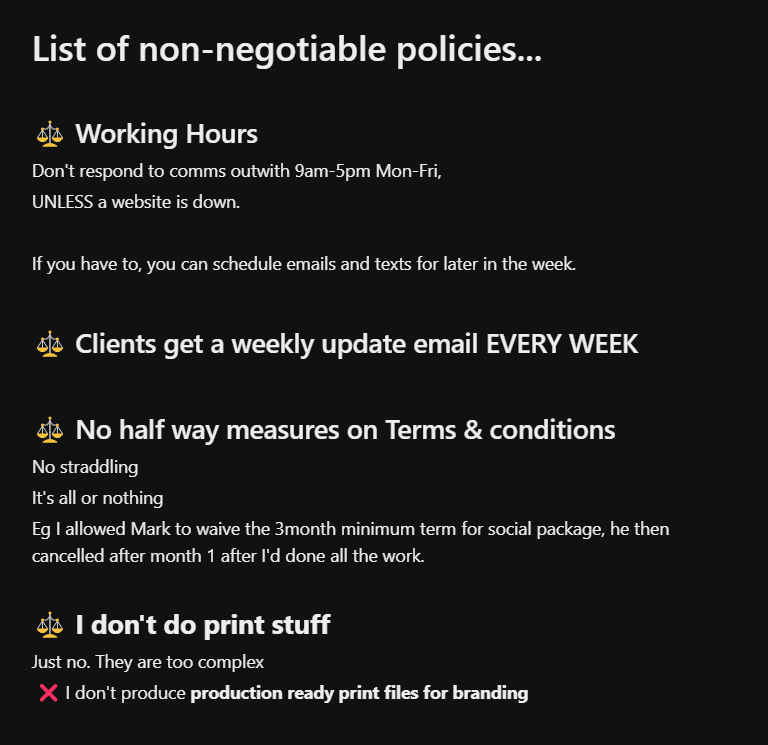“I’ve heard the same client sob story a million times before,” she said. “And while it’s fine to vent, if you keep making the same mistakes your going to keep getting the same results, and I might have vent my own frustrations on you with the nearest sharp object.”
Fair enough.
My wife has listened patiently over the years to the same difficulties that come up over and over again for a designer.
If I have a bad day at work, someone is shouting at me, and someone’s website has gone down.
If she has a bad day at work, someone has poo’d on her shoes and someone has died.
Remembering this really helps me gain some perspective on what’s important.
Most things aren’t a big deal.
But everyone needs to vent sometimes, which can be hard as a remote worker.
Every time I get together with anyone in a creative field, we spend hours bitching and moaning about the same thing: difficult clients.
We all share the same memes,
And we all have the exact same stories.
In fact, I wouldn’t be surprised if all designers in the world were working for the same 3 people. 🤣
Over the years, I like to think I’ve become adept at dealing with these types of clients,
and also at spotting potential issues and heading them off at the pass.
Clients need to be guided and herded and managed carefully,
It’s probably the no 1 headache freelancers face.
but it’s also the trickiest because it involves a variety of different “soft” skills.
Some freelancers never acquire these skills,
and get stuck in the zone of undercharging, underappreciated, trodden over, resenting their own clients.
So instead of storming downstairs in slippers and ranting to my wife about the latest misdeed from my errant client,
I catalogue all my mistakes, and how I will deal with them in future.
This week on Life by Design, I’m sharing my many mistakes and how to prevent these issues entirely rather than running about trying to fix them.
The freelancer’s guide to managing difficult clients
Firstly:
A good designer never blames his clients. Even the bad ones.
I like to say that there are no “bad” clients,
only badly managed clients.
but unfortunately that’s not quite true.
It would be more accurate to say most clients are a pleasure to deal with but the unpleasant few can make your life a living hell,
and those few are the ones that stick in your memory,
and thus get talked about when creatives get together.
The first rule of managing clients
This is the pareto principle is in play here:
20% of your clients will consume 80% of your time.
But even the “bad” clients just need more time and attention.
That’s not to say you should be compensated more for investing more time in the client.
But don’t blame the client for it.
It’s a bit like training dogs. 🐕
The first thing a dog trainer does is train the owner.
It’s not the dogs fault if the owner keeps feeding them at the table.
Clients misbehave when your own behaviour is incorrect.
So let’s start spotting the red flags, and adjusting our behaviour…
Why do clients misbehave?
Understanding WHY they are misbehaving is the first step towards reparation, and prevention in the first place.
Let’s go back to our dog training…
Here’s the most common reasons my dog Ramsey likes to misbehave:
🔹 He doesn’t trust my judgment as pack leader
🔹 He is used to being top dog in his pack. it takes an adjustment to cooperate instead of command.
🔹 He feels compelled to try take charge of things
🔹 He is afraid or insecure
🔹 He has been bitten in the past (this explains a lot of bad behavior)
🔹 At granny’s house, He is allowed to sleep on the sofa and eat off plates.
🔹 He is not used to being told “No”
🔹 He is wound up, tired or having a bad day.
🔹 Usually if he barks, he gets what he wants from people.
Sound familiar? 🤔
How to say no to clients
Take a tricky client I had today. They were spitting the dummy out when I finally put my foot down and said any more changes would be billable.
From my POV, “I allow a lot of flexibility. They’d already had a few freebies, yet they were somehow annoyed at me I wasn’t doing any more free work.”
From their POV: “this stuff had been free, why am I suddenly having to pay for it, you’re removing something I already own!”
The funny thing about humans is that nobody ever believes they are being the asshole.
Your client always has a reason for behaving the way they do, even if it’s not apparent to us at the time.
Understand the reason, solve the problem.
The reason was poor comms on my part.
The problem was I allowed changes outside my usual process,
I hadn’t communicated a cap on it,
so the client naturally kept coming back for changes on their changes,
until I told them no.
From their perspective this was not the end of a long line of favours,
but a reduction in the service they had come to expect.
What I should have done
Communicate from the start the limits of the favour,
and how many revisions were included without billing extra.

Obviously, I had to correct the situation,
But changing the arrangement encounters more resistance,
than setting the expectation in the first place.
TBH, a lot of web designers find it very hard to tell clients “No” like this.
It’s very difficult for me to do too. In fact, it took me hours to draft a boundary setting email because I kept second-guessing the line between firm and polite.
It’s a bit of an art to say no in a polite way whilst still being firm.
It’s a very difficult thing to do, but if you don’t do it, it only leads to more problems later.
Clients learn how far they can push you until you say no.
And if you don’t say no, they’ll continue to take advantage.
It’s a bit like training dogs. If you let them misbehave, they will continue to misbehave.
If you are strict, they won’t like that you don’t give them what they want, but they will learn that you can’t be pushed.
This is far better for the relationship long-term.
Clients will often NOT be happy to receive an email like this.
They might even be angry for a bit. But the short-term being annoyed at you is much better than “pleasing the client” for one email, then having a project that is really badly run for months.
So often it’s better to tackle the problem head-on and quickly.
This is often more uncomfortable than just saying yes.
Remember:
“Your success in life is measured by how many awkward conversations you’re willing to have. – Tim Ferris”
Don’t Get Frazzled
Don’t take things personally.
The next time you get wound up by clients, just remember:
it’s all part of the game
Your job is to do the best you can to help them with the skills you have. It’s not your job to fix all their life problems.
Example:
I ran a PPC campaign for a client who was complaining about poor results.
But the numbers don’t lie: click-through rate was great.
The problem was the website and I advised them honestly about this and offered to fix it,
but of course this would require more budget
This is incredibly stressful.
Facing an irate customer can feel like a personal assault.
At this point many freelancers attempt to offer freebies to placate or stop the attack.
It’s not your job to accept responsibility for problems that existed before you started working with them.
It’s your job to advise honestly, so tell them the reason plainly:
“You’re not getting leads because your website sucks! Want help with that? it’ll cost this much to fix it”

Setting Boundaries with clients
The most common reason for boundary issues is simply being caught off-guard.
Unfortunately, a lot of these issues won’t occur to you till you get caught with your pants down.
But you’ll add them to your list for the next time.
Sit down and set your “non-negotiable policies”
Writing things down helps reinforce them:
▶️ I will not answer my phone outside working hours
▶️ I will not start the project until all content and details have been provided
▶️ I will not proceed with the project until the client has signed off on the feedback
▶️ I will not respond to WhatsApps
▶️ I will not type up my clients’ handwritten notes
▶️ I will not allow invoices to go more than 2 days late
▶️ I will not fix your printer for you
Notice that these are all “I” statements. We are setting OUR boundaries.
You cannot control your clients’ behaviour. You can only control your reaction to their behaviour.
Setting Non-negotiable Policies
Setting boundaries, policies, and rules is important for the wellbeing of both parties.
Here’s an example of WHY:
In the UK cars drive on the left. Everyone follows the rule and everyone gets along.
But bikes sit in an ambiguous grey area.
- Sometimes bikes can go on roads with cars.
- But sometimes bikes aren’t allowed on roads.
- Sometimes bikes can go on pavements with pedestrians.
- But sometimes bikes aren’t allowed on pavements.
- Sometimes bikers ignore the rules on pavements
- Sometimes cars don’t respect bikers on roads.
This confusion leads to all sorts of heated arguments & accidents.
Bikes are hated by both pedestrians and motorists alike.
Poor bikers. 🚲
Have you ever been to Amsterdam?
In Amsterdam, there are VERY clear rules on where buses, cars, bikes, and pedestrians should be.
If a tourist doesn’t know this and happens to step into a bike lane, or cycle on the road, the locals firmly and quickly put them back in their place.
All four modes of transport operate quickly, efficiently, and agreeably.
Bikes, pedestrians, scooters, cars, and all sorts of transport whizz along at lightning speed,
with no conflicts or issues.
Everyone knows the rules and everyone gets along.
Generally, we want to try to set our own rules for our decisions:
IF this, THEN that.
We try to stick to this as much as possible. People understand rules and policies.
When policy isn’t set, this is when we enter ambiguous grey areas, which is where arguments happen.
When the client wants X, but you don’t want to, the easiest thing is just to cite your policy:
“The policy is that I have to charge a rush charge for any work that needs a rapid turnaround……”
“The policy is we can only accept content via the Google Doc……”
“The policy is if it’s extra work outside the scope, it’s billable……”
Know what you will and won’t do in advance, write it down, and keep a list.
Never do anything you aren’t 100% happy to do, as you’ll only end up resenting the client for it.
I create a new policy for each mistake I’ve made.
Each time I get caught out, I add a new rule to my list. Over time, this has built up into a comprehensive guide for managing client relationships.

Always Give a Reason Why
Rules are great, but studies show people are more compliant, understanding, and reasonable when a reason for rules is given.
The funny bit? Any reason will do. But logical reasons are better.
“The policy is that I have to charge a rush charge for any work that needs a rapid turnaround, because I have to pull my team off of other projects and may have to pay them overtime.”
“The policy is we can only accept content via the Google Doc, so that we don’t miss anything.”
“The policy is if it’s extra work outside the scope, it’s billable, so that I can cover the extra time.“
When to Make an Exception to a Policy
This rule will save you a lot of pain:
The client you make an exception to your rules for,
is the type of client you made the rules for in the first place.
Making exceptions to policy will often sting you in the ass….
But we live in the real world.
Sometimes you have to break rules for special cases.
This is when it can be hard to make a clear decision.
Key Decision Factors:
🔹 What was the original scope?
🔹 What is the client budget? Does it accommodate wiggle room, or are they on a super tight budget?
🔹 How much time/resources do you estimate this decision will need?
🔹 Is this a one-off, or likely to reoccur?
🔹 Whatever you decide now will become the new policy from now on
🔹 If you do something for free once, expect to do it free forever (unless you specifically say this is a one-time thing)
🔹 What is the future impact for making an exception to policy now?
🔹 How organized are they? Even the smallest of favors can turn into mammoth tasks if the client isn’t tech-savvy or organized
🔹 How agreeable are they?
In real life, we know people that are more or less agreeable, and we adjust our behaviour based on this…
The Balance of Goodwill
To make a decision on fringe cases, or exceptions,
I hold an imaginary sliding scale for each client, which tips in one direction or the other. This scale is abstract and not based on any real metrics.
A client is in bad favor:
|–🔴——!———-|
A client is in good favor:
|———–!—–🟢–|
This scale tips depending on how good the relationship is with the client:
- Have we made any mistakes, or failed on our promise?
- How many favours have we granted already?
- How nice have they been?
- How tolerant / patient / reasonable has the client been in the past?
- Have there been any red flags?
- What is their budget?
This sliding scale has a big impact on decision making, particularly when it comes to making exceptions to policy.
Clear Communication
I’ve already written an in-depth guide to clear communication with clients and strategies for cutting your email inbox in half: “Tell them twice, email them once!”
Tell them twice
I’m not suggesting you call the client twice to tell them their next invoice is due in 2 weeks, however, it doesn’t hurt to reiterate important points whenever you catch up.
Put it on writing too
After you discuss an important milestone or instruction on the phone, email them afterwards to confirm in writing so you can refer back to the email later if needed in a dispute.
It doesn’t need to be legal or formal, just something like this:
“Hi xxx, here’s what we discussed on the phone; I’ll proceed with option A. Payment for the last invoice will be due in 3 days time. Catch up soon! ☺”
The client should never have to say “I wasn’t aware of that!”
I can guarantee that they will still say they weren’t aware.
Unfortunately, you will always get a few clients who are either:
A) Unorganized
B) Use this technique as a bargaining tool or evasion measure
Then you point out your two calls and the follow-up email where you told them that, which puts the ball back in their court.
Be patient on this.
With so many forms of comms, it’s easy to miss stuff.
On that note…
Narrow Your Communication Channels
Choose your communication channels and stick to them.
We all have those clients that IM at 9pm and expect a reply within 10 mins.
I’d add personally I don’t allow clients to use WhatsApp or any instant messaging for comms.
Instant messaging leads to:
- Unrealistic response expectations
- Bad communication habits
- Disorganization
- Brain farting and verbal diarrhea
Obviously, let them know in advance in your onboarding you don’t respond to IMs unless by prior arrangement (for something like a 2FA code).
If a client IMs you, and you reply to say you don’t respond to IMs, you have just responded, and they know they can get your attention via IMs. Even reprimanding them gets them the result they want.
If you must, send one message to ask them to email you it over. After you send that message, DO NOT REPLY. No matter what.
Replying opens a dialogue. I know it’s tempting. I’ve caved in myself a few times.
They always think it’s mega urgent but it rarely is. 90% of the time, by the time you open the message thread again on Monday, they’ll have fixed the problem themselves.
So best to just ignore. They will get the point and email you instead, as that gets the best response rate.
I stick to email, live calls, and looms. If it needs a live discussion, then I do that on a zoom call at a prearranged date and time for a major feedback milestone.
To manage clients well, adjust your own behaviour first
The moment you break your rule, the line has been broken, and it’s very hard to redraw the line.
If you do something once, be prepared to do it again.
It may seem impossible to hold the line right now, under pressure or anger.
But trust me, it’s going to be even harder to reset that boundary later.
So stick to your guns. Work that muscle. Practice removing emotion.
Be prepared
If you know you’re going to have a tricky conversation, have a prepared quote or response ready, so you aren’t caught off guard and blurt something out.
Setting Levels of Acceptable Behaviour
I like to think my own dog is quite well behaved.
But he still barks at the postie after years of trying different things.
If I put in enough time and effort, I’m sure we would overcome this.
But there’s only so much time in the day, and this behavior crosses the threshold of the time I’m willing to commit to dog training.
It’s a small annoyance we now live with.
This is something you’ll need to figure out:
What is the threshold of bad behavior that you are willing to accept?
It’s different for everyone.
More money helps. (Just being honest here 😅)
I’m willing to accept a little bit more flak from someone who’s paying me more.
Make Allowances – See the Best in People
When people are really bugging you,
remember we are all doing the best we can with the knowledge and self-awareness that we have.
Plus, people have bad days,
they have personal issues,
they run late.
You don’t have to let people walk all over you,
but always give the benefit of the doubt and a second chance.
Don’t take it personally;
they probably just don’t know any better.
They aren’t an expert, after all!
Most often, people don’t set out to annoy you,
they just have different priorities
















